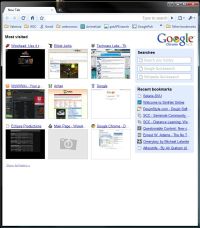|
Chrome: Google's Shiny New Browser

Google-Eyed
From the beginning, Google has been well-known for introducing simple, well-designed products that redefine people's expectations. From google.com itself and its revolutionary PageRank system, to popular web applications like GMail and Google Maps, Google has carved out a huge market share in almost every field they've entered. Now they've turned their sights on the area that is most key to their business: the web browser. Does Chrome shine like its namesake, or is it a dull imitator? Let's have a closer look.
Another Browser? Why Bother?
Web search may be the foundation of Google's success, but a large part of their relevance today depends on web applications. GMail, Google Video, Google Calendar, these and many more of Google's applications are built on AJAX. Short for Asynchronous Javascript And XML, AJAX is the main reason web pages have become so much more interactive. Unsatisfied with how the current browsers handle Javascript and XML, Google set out to make a browser that follows their basic ethos: fast, efficient, clean, and no unnecessary extras. If you want to know more about the underlying technology, Google will be happy to tell you in detail. What we'll be focusing on today is the end result of their effort. After all, bright-eyed enthusiasm is all fine and good, but what we really care about is the result, right?
Initial Reflections
Getting ahold of the browser is easy enough. A trip to the Chrome website will present you with a link for the Windows installer. There are no Mac or Linux versions out yet, but Google promises they'll be out Real Soon Now. The installer itself is a stub, the actual program data is downloaded during the install process. This makes it mandatory to be connected to the web during install—a minor inconvenience if you've got a cut-rate DSL line or dial-up connection, but hardly an issue given the program's compact size.
Once installed, it offers to import bookmarks and settings from whatever browser you have set as your default, then loads the browser window itself. This shot is from an install that's been used for a few weeks, but this is more or less what you'll get:
One thing you'll notice immediately is that there is no menu bar. Taking a page from IE7's design, Chrome does away with the menu bar, instead condensing those less-frequently-used commands into the Page and Control buttons on the right-hand side of the toolbar. Also missing is a separate search bar; searches and url's are both handled by the universal bar up top. Entering google stuff into the bar will begin a google search for stuff, for example. Quick searches are also pre-made for Wikipedia, Yahoo!, Windows Live Search, Answers.com, and Ask.com.
Probably the most noticeable feature is the tab layout. Doing away with the traditional title bar, Chrome puts the browser tabs up top, with a + button to the right for quickly opening a new tab. Switching between tabs is a matter of a single click, and you can grab a tab and drag it outside of its container window to put it in its own new window.
Browsing on the Sly
Looking at the options in the Page button on the toolbar reveals another new feature: Incognito browsing mode. Choosing this option brings up a new window with a Spy-vs-Spy type character in the upper left, and (depending on your system theme) a darker window border. Pages visited while in incognito mode will not show up in Chrome's history; cookies and cached page info for incognito tabs disappear when the tabs are closed. This is perfect for browsing on a friend's computer without leaving a (ahem) trail of evidence. Bookmarks created and files downloaded while in Incognito mode remain, however, so you still need to be careful. Incognito also does nothing to secure you against phishing attacks, ISP's or corporate netadmins monitoring your net traffic, or anything else beyond the browser itself. Care and vigilance are still your best friends when seeking to browse securely, Incognito just takes one of the items off of your list of "things to watch out for".
Slick and Slide
Now that we've admired the interface, let's see how this browser performs in the real world. Loading up GMail, YouTube and Pandora Radio was fast, as expected. In fact, page rendering in general is the fastest I've seen yet on any browser. Several times, I got the distinct feeling that if my connection were faster, the page would come up instantly. Over the years, we've gotten accustomed to punching in a web address, then waiting over the course of 10-15 seconds as the page elements load and sort themselves into their proper order. Using Chrome, however, the content pops up just as fast as it comes down the pipe. Here's a comparison chart of load times taken with a stopwatch.
IE7 |
FireFox 3 |
Chrome |
|
|---|---|---|---|
GMail (from login) |
6.54 |
5.32 |
2.66 |
YouTube |
6.47 |
4.04 |
3.48 |
Pandora |
10.94 |
8.67 |
10.52 |
While not perfect across the board, Chrome still manages to edge out the competition in loading times. While a difference of a few seconds may not seem like a lot, multiply that by a couple hundred web pages a day, and you can see how the wasted time adds up.
REALTIME PRICING





